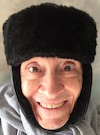 I suppose it had to end sometime. We enjoyed unseasonably warm weather up through November 9, with Anna bringing in the final harvest of our figs, tomatoes, and several varieties of basil earlier this week. I ate the very last of those figs — halved lengthwise, toasted for 5 minutes, warm and succulent — this afternoon.
I suppose it had to end sometime. We enjoyed unseasonably warm weather up through November 9, with Anna bringing in the final harvest of our figs, tomatoes, and several varieties of basil earlier this week. I ate the very last of those figs — halved lengthwise, toasted for 5 minutes, warm and succulent — this afternoon.
Yesterday turned wintry cold, and today it’s bitter cold out there, down to 26F in Central Park last, breaking a record set in 1914. Meanwhile we’re cozy inside, though Anna and Jacky still have to finish winterizing the garden and Billie the Bengal insists on going out several times a day with only her fur coat to protect her.
As I write this it’s 1 p.m. on Saturday, November 11, and she’s exhausted from her chilly garden adventure, full of lunch, and asleep on a denim-covered pillow in the little cloth-lined cave I’ve made for her from an old cotton pillowcase in a converted pet cage:
•
Jill Freedman: Old News: Resurrection City
[The Stephen Kasher Gallery currently features a show by Jill Freedman, reviving her project from the late 1960s, “Resurrection City.” This prompted me to dig into the archives and retrieve my review of the book version of that project, which appeared under the title “Children, Poverty and Black Women” in my New York Times column on January 17, 1971.
I consider Freedman a seriously under-recognized documentary photographer, so I recommend this show highly. And someone should reprint this book, which has lost none of its power (or timeliness) over the intervening half-century.— A. D. C.]
Perhaps because I was once involved in editing an abortive project on Resurrection City (for a publisher who finally decided that the subject was dead and buried — that was in 1968), I am particularly delighted to see Jill Freedman’s Old News: Resurrection City (Grossman Publishers, $4.95 paperback, $10 hardbound).
Resurrection City may well be old news today — in fact, what it represented was old news even before the first shanty went up — but it was also one of the major symbolic gatherings of the sixties, equal in its significance to the 1967 march on the Pentagon. Both events demonstrated with abundant clarity just how remote our obsessively bureaucratic government has become from the people it no longer seems to serve, and both indicated the apparent uselessness of petitioning for any redress of grievances.
Yet if Resurrection City made one thing perfectly clear — that Washington really didn’t give a damn about the poor — it also established a mood of militancy among the skeletons who resided in that open-air closet. No more silence, no more invisibility.
Jill Freedman was there from the beginning and remained to the bitter end, living with the people who make up her book. This is probably why her visual-verbal narrative concerns itself less with the overly-documented “events” of the City’s brief history (the massive demonstrations, the visits by various dignitaries) and concentrates on the inhabitants, the mood and the lifestyle. It is a very personal yet highly objective statement, filled with passion, warmth, sorrow and humor. Freedman’s pictures are deft and strong; her text witty, sardonic and honest, with quirky insights and touching moments of self-revelation. A brave and moving book. Resurrection City may have been old news, but those who inhabited it — Miss Freedman included — refreshed each other and their time.
Angle of Vision
I enjoy Teju Cole’s “On Photography” essays for the New York Times. He usually pays close attention to the pictures, unlike so many who write about this medium. And he develops interesting insights, as in his most recent meditation, “The History of Photography is a History of Shattered Glass,” published on November 15.
The title’s more than a bit hyperbolic, even when intended metaphorically. “Glass is everywhere in photography,” Cole asserts correctly, but there’s not a lot of broken glass in the cumulative imagery from which we construct our understanding of the medium’s history. He could more easily have argued that said history is a history of faces, or trees, or women’s breasts, or transportation vehicles. But let’s allow him this poetic license, since he takes the broken windows in news photographs of the Mandalay Bay hotel in Las Vegas, from which mass murderer Stephen Paddock unleashed a dose of hell on earth on October 1, as his point of departure.
Midway through this piece, however, Cole reproduces and comments on a Brett Weston photograph, “Untitled (Broken Window, San Francisco),” 1937.
Here’s some of what Cole has to say about it:
“What has been broken away dominates the picture. We see an outline like a map of a fictional island. There’s more dark to see here than glass, and the darkness is deep and mysterious, a mouth agape in an unending scream. About this picture, John Szarkowski, the influential curator at the Museum of Modern Art, wrote that the black shape ‘is not a void but a presence; the periphery of the picture is background.’ In the middle, in that darkness, is where Weston’s self-portrait would be, if the window were intact.”
Well now. When we pay close attention to this picture its perspective tells us that Weston made this negative with his camera positioned not directly in front of the window but somewhat below it, tilted upward, as indicated by the evident fact that the window frame appears narrower at the top of the image than at the bottom. Moreover, we can see that, even so, the negative does not squarely address the window from an exactly frontal point of view; we see a bit more of the wooden window frame at the bottom left than we do at the bottom right; that effect is reversed at the top edge of the image.
Knowing (from personal experience, in my case) that San Francisco streets are frequently hilly, this suggests the likelihood that Weston made his negative by adjusting his tripod so as to compensate for the slope of the sidewalk, positioning his 8×10 view camera so that his negative would encompass the entirety of that hole. The fact that, on the upper right-hand edge, we can see a bit of the masonry opening in which the window frame is contained, but only the very edge of that opening on the left, tells us that the camera (and Weston himself) stood slightly below and to the left of this window to make this negative.
Architects commonly locate urban ground-floor windows somewhat above eye level, for the sake of the occupants’ privacy, hence this vantage point of Weston’s should not surprise us. Since photographers working with view cameras normally position their instruments at their own eye level, so as to study on the camera’s ground glass what the lens sees, we can assume that Weston had this cumbersome camera as high as it could go on its tripod while still allowing him to scrutinize what he had framed and previsualize the resulting print.
Which means that — as John Szarkowski, himself a view-camera photographer before he became a curator at the Museum of Modern Art, and Teju Cole, a photographer himself, should both have known — even if Weston had moved to the right of his camera, planting himself directly in front of the window, and stood on tiptoe, his reflection would not have appeared in the center of that image. Which makes Cole’s claim that “In the middle, in that darkness, is where Weston’s self-portrait would be, if the window were intact” sheer nonsense.
Charming and poetic nonsense, to be sure, but nonsense nonetheless. And a critic’s poetic license automatically gets suspended whenever the data encoded in an image contradicts the flight of fancy.
Portrait In Depth
I rarely find myself returning to a news photograph for its nuances. But Saul Loeb’s image of Donald Trump, Ivanka Trump, and Jared Kushner from a Cabinet Meeting in the Cabinet Room of the White House in Washington, DC, October 16, 2017, proves an exception.
It appears as the lead illustration for “‘You Can’t Go Any Lower’: Inside the West Wing, Trump Is Apoplectic as Allies Fear Impeachment,” Gabriel Sherman’s November 1, 2017 Vanity Fair report. Here’s a screenshot:
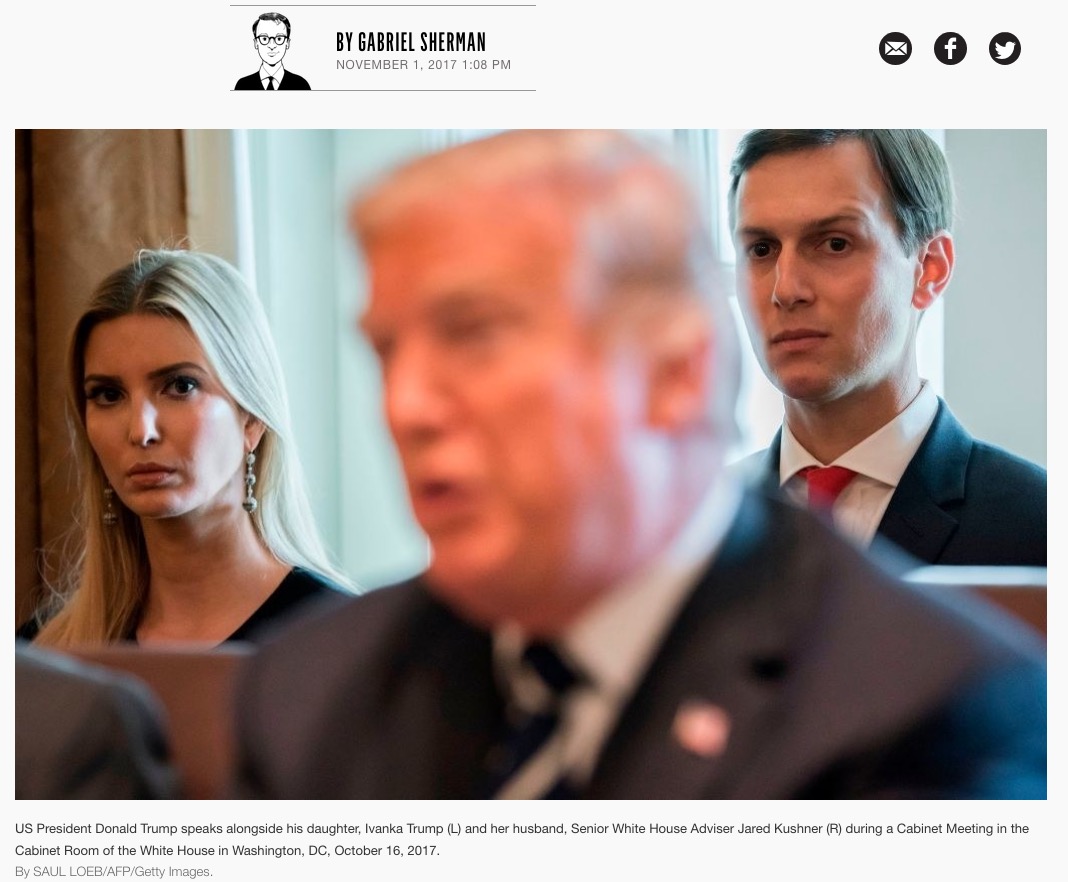
Ivanka Trump (l), Donald Trump (center) Jared Kushner (r), White House, October 16, 2017. Photo by Saul Loeb. (Screenshot from Vanity Fair feature article, November 1, 2017.)
Certainly unusual to have a large, looming out-of-focus mass in the foreground, occupying close to half of the entire frame in what’s nominally a news photo. My congratulations to Loeb for making it, and to his picture editor at Vanity Fair for choosing it over more conventional images from the same session.
Because this one resonates. There you have POTUS, portrayed as an unfinished plasticine bust, features barely roughed in, almost unrecognizable were it not for the two immediately identifiable figures behind him. And there in the background you have daughter Ivanka and son-in-law Jared, in sharpest focus, looking like terrified birds so hypnotized that they can’t avert their eyes even when the snake turns its head away from them. Staring at him but also, or so it seems, simultaneously staring at you, the viewer.
•
 Special offer: If you want me to either continue pursuing a particular subject or give you a break and (for one post) write on a topic — my choice — other than the current main story, make a donation of $50 via the PayPal widget below, indicating your preference in a note accompanying your donation. I’ll credit you as that new post’s sponsor, and link to a website of your choosing. Include a note with your snail-mail address (or email it to me separately) for a free signed copy of my 1995 book Critical Focus!
Special offer: If you want me to either continue pursuing a particular subject or give you a break and (for one post) write on a topic — my choice — other than the current main story, make a donation of $50 via the PayPal widget below, indicating your preference in a note accompanying your donation. I’ll credit you as that new post’s sponsor, and link to a website of your choosing. Include a note with your snail-mail address (or email it to me separately) for a free signed copy of my 1995 book Critical Focus!
 But wait! There’s more! Donate now and I’ll include a copy of The Silent Strength of Liu Xia, the catalog of the 2012-13 touring exhibition of photos by the dissident Chinese photographer, artist, and poet, currently in her sixth year of extralegal house arrest in Beijing. The only publication of her photographic work, it includes all 26 images in the exhibition, plus another 14 from the same series, along with essays by Guy Sorman, Andrew Nathan, and Cui Weiping, professor at the Beijing Film Academy.
But wait! There’s more! Donate now and I’ll include a copy of The Silent Strength of Liu Xia, the catalog of the 2012-13 touring exhibition of photos by the dissident Chinese photographer, artist, and poet, currently in her sixth year of extralegal house arrest in Beijing. The only publication of her photographic work, it includes all 26 images in the exhibition, plus another 14 from the same series, along with essays by Guy Sorman, Andrew Nathan, and Cui Weiping, professor at the Beijing Film Academy.


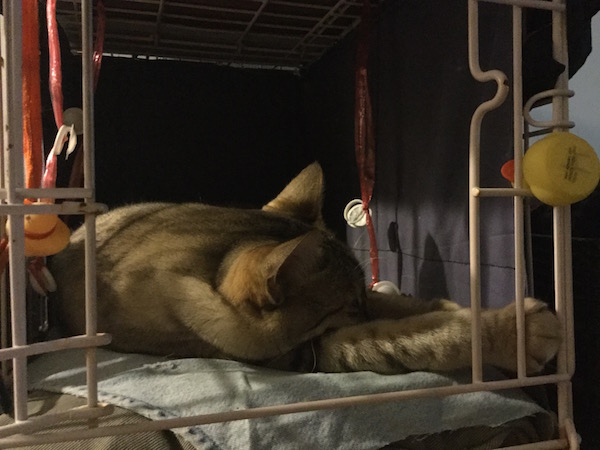
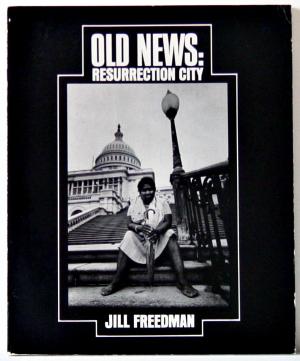
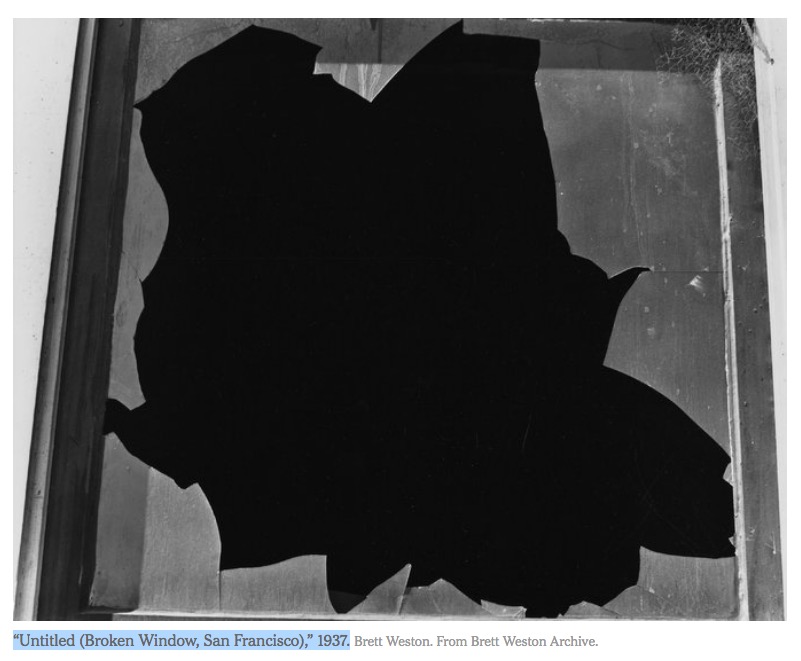
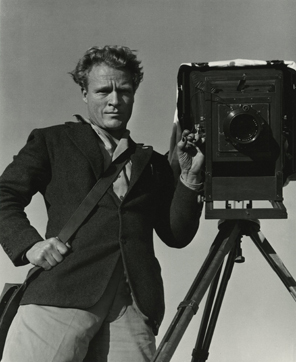




Looks to me like he blurred Trump in post processing…but am no expert. You check it out A.D.
You are lucky to have fresh figs. In the rustbelt, when you can find them, which is seldom, they sell for .99 to $1.29 each fig. Most are the less desirable brown turkey variety. I grew up in L.A. with white figs and black mission figs trees in my backyard.
Szarkowski? He was as anal as they come.
https://www.lensculture.com/articles/john-szarkowski-john-szarkowski-photographs
Just the most god awful boring photos as one could hope to make…on purpose. I have nothing in common with photography.
But, he was good as writing intellectually at length, something that is right up your alley A.D.
Given the increasingly stringent codes of ethics and the level of punishment meted out nowadays to photojournalists and picture editors who make even minor alterations to digital files, the chances of Saul Loeb, Agence France Presse (AFP), and Getty Images conspiring to send out an image with its central figure “blurred … in post processing” are slim to none — and, as the old saying goes, Slim done left town.
And why would Loeb have bothered do that, when he could simply put The Donald out of focus by adjusting his depth of field, as he so obviously did?